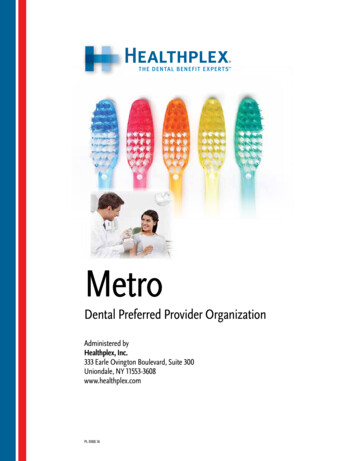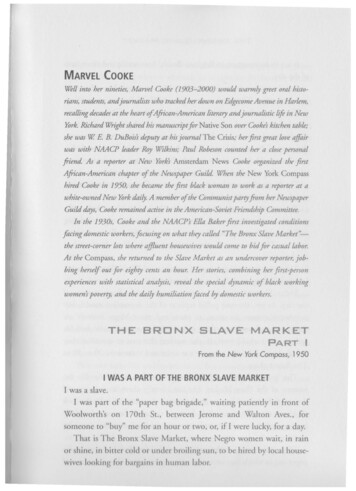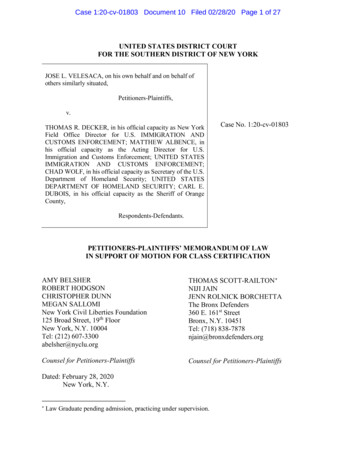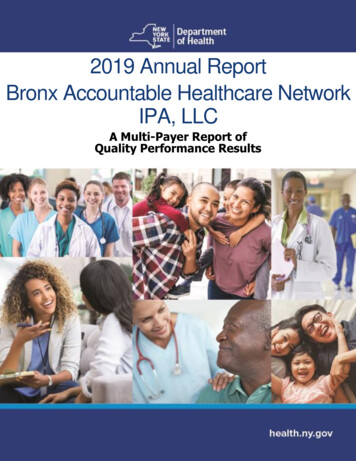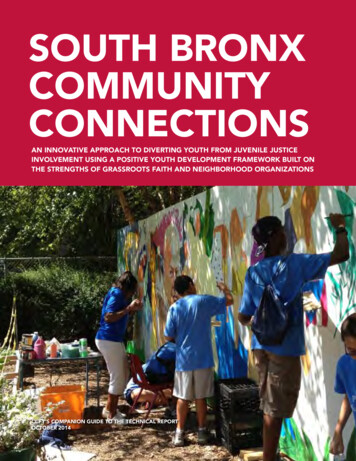
Transcription
SOUTH BRONXCOMMUNITYCONNECTIONSAN INNOVATIVE APPROACH TO DIVERTING YOUTH FROM JUVENILE JUSTICEINVOLVEMENT USING A POSITIVE YOUTH DEVELOPMENT FRAMEWORK BUILT ONTHE STRENGTHS OF GRASSROOTS FAITH AND NEIGHBORHOOD ORGANIZATIONSCCFY’S COMPANION GUIDE TO THE TECHNICAL REPORTOCTOBER 2014
ABOUT COMMUNITY CONNECTIONS FOR YOUTHCommunity Connections for Youth (CCFY) is a Bronx-based nonprofitorganization whose mission is to empower grassroots faith and neighborhoodorganizations to develop effective community-driven alternatives to incarcerationfor youth. CCFY believes that increasing local community capacity to workwith youth in the juvenile justice system is the key to reducing youth crime anddelinquency and improving long-term life outcomes for youth.ABOUT SOUTH BRONX COMMUNITY CONNECTIONSSouth Bronx Community Connections (SBCC) is a research demonstrationproject funded by a JJDPA Formula Grant from the New York State Divisionof Criminal Justice Services (DCJS). The JJDPA Formula Grant commissionedCCFY to develop an innovative strategy for juvenile justice reform built on thestrength of grassroots faith and neighborhood organizations. The South BronxCommunity Connections project was independently evaluated by the John JayCollege of Criminal Justice.About the Companion Guide to the Technical ReportCCFY produced this Companion Guide to the Technical Report to summarize the most importantfindings of the South Bronx Community Connections evaluation for a general audience. TheCompanion Guide presents both the evidence-based findings from the John Jay evaluation,along with promising developments for which there are not yet sufficient data for inclusionin the technical evaluation. CCFY references the John Jay technical report throughout thisCompanion Guide. However, the information presented in this document, along with the policyrecommendations we put forth, is ours alone. Those interested in reading the full technicalevaluation can download the report by the John Jay College of Criminal Justice from our websiteat http://cc-fy.org/sbcc-downloadRecommended CitationCommunity Connections for Youth (2014), South Bronx Community Connections: An innovativeapproach to diverting youth from juvenile justice involvement using a positive youth developmentframework built on the strengths of grassroots faith and neighborhood organizations. Bronx, NY:Community Connections for Youth.
CCFY’S COMPANION GUIDE TO THE TECHNICAL REPORTSOUTH BRONXCOMMUNITYCONNECTIONSAn innovative approachto diverting youth fromjuvenile justice involvementusing a positive youthdevelopment frameworkbuilt on the strengthsof grassroots faith andneighborhood organizations.
A SUMMARYOF FINDINGSSouth Bronx Community Connections is a threeyear pilot project implemented by CommunityConnections for Youth (CCFY), a Bronx-basednon-profit organization dedicated to buildingcommunity capacity for juvenile justice reform.Through the SBCC project, CCFY demonstratedthat a collaborative grassroots approach couldsuccessfully divert neighborhood youth fromfurther juvenile justice system involvement byengaging them in positive youth developmentprogramming built on the strengths of localgrassroots faith and neighborhood organizations.South Bronx Community Connections (SBCC)was funded with a federal Juvenile Justice andDelinquency Prevention Act (JJDPA) formula grantfrom the New York State Division of CriminalJustice Services (DCJS). The grant was awardedto CCFY under the category of “BreakthroughResearch-Based Strategies.” The funder wasseeking an innovative approach to the problemof youth crime and delinquency that had thepotential to be a “game changer” in the fieldof juvenile justice. DCJS awarded a 1.1 milliongrant to CCFY to create a new model underone condition: that the project be developedunder rigorous evaluation from an independentresearch entity. The John Jay College of CriminalJustice was selected to serve as the independentevaluator for the SBCC project.South BronxCommunity Connections(SBCC) is aninnovative approachto diverting youthfrom juvenile justicesystem involvementusing a positiveyouth developmentframework built on thestrengths of grassrootsfaith and neighborhoodorganizationsBefore beginning to serve youth, CCFY spent aplanning year working with an evaluation teamfrom the John Jay College of Criminal Justice2SOUTH BRONX COMMUNITY CONNECTIONS: COMPANION GUIDE TO THE TECHNICAL REPORT
Figure 1.Map of Community Board 1, 40th Police PrecinctE.159th.E. 149tkarh St.eAvSt.E. 161th StP.ectProspMELROSEBetancesMOTT HAVENBrook ParkJehova ShammahFamily InstituteISerRivverRistEaZip Codes:10451, 10454, 10455, 10456SOUTH BRONX COMMUNITY CONNECTIONS: COMPANION GUIDE TO THE TECHNICAL REPORT 3St.mFreedomCommunityCenterE. 149thCCFYAve.YUCArleHaFurthermore, the SBCC project focuses on youthdeemed likely to remain chronically involvedin the juvenile justice system absent earlyintervention. SBCC serves youth who have alreadybeen arrested on charges that are normallyprocessed through the system (i.e. assault,theft), providing a community intervention as analternative to formal processing in through thejuvenile justice system. If youth complete 60 dayswith SBCC without getting into further trouble,their cases are closed and their records sealedwith no further justice system supervision. Whilethe short-term mandate lasts for only 60 days,CCFY is committed to keeping youth engaged ina network of community support for an indefiniteperiod of time.Community Capacity Building: identifying preexisting faith and neighborhood organizationsalready involved in serving youth in thecommunity, and further developing theircapacity to partner with the juvenile justicesystem through the provision of sub-grants,training, and technical assistance.RR3. CCFY was — and is — headquartered inMott Haven and was already deeply connectedto numerous grassroots faith and communityorganizations in the neighborhood.Family Strengthening: involving the familymembers of system-involved youth insupportive social networks to decrease isolationand increase social support.O2. working within a single neighborhoodallowed SBCC to develop meaningfulpartnerships with the local police precinct,neighborhood schools, and other systempersonnel; andPositive Youth Development: facilitatingadolescent development by involving youthin neighborhood improvement projects withpro-social peers, facilitated by positive adultmentors from within the community (i.e.“credible messengers”)M1. the neighborhood had historically high ratesof youth crime and delinquency and supplieda disproportionate number of youth to thejuvenile justice system;System Partnerships: developing collaborativerelationships with local juvenile systemstakeholders (probation, prosecutors, police) todivert youth who would otherwise be advanceddeeper into the juvenile justice system.RTThe SBCC project initially focused on the SouthBronx neighborhood of Mott Haven (Figure 1),a community in the heart of the nation’s poorestCongressional District. CCFY chose Mott Havenfor three reasons:The SBCC project employs four intertwinedstrategies to further CCFY’s vision of buildingcommunity capacity for juvenile justice reform:POto develop the tools necessary for a rigorousevaluation. Under the guidance of the evaluationteam, CCFY developed a Theory of Change, aLogic Model, and an online database. These toolsallowed CCFY to capture the data needed for theprocess evaluation, and to measure SBCC’s targetpopulation against a borough-wide comparisongroup. The planning year was also used toreview local juvenile delinquency data, cultivaterelationships with juvenile justice agencies, andengage local grassroots faith and neighborhoodorganizations as partners for the initiative.
LATINA VEGA PHOTOGRAPHYSBCC’S CORE VALUESSBCC’s theory of change reflects the deeply heldvalues on which CCFY was founded. The project intentionally departs from the deficit-based approachthat relies on professionalized resources externalto “deprived” communities to “fix” the problemsof “at-risk youth” from “dysfunctional families.”Instead, CCFY uses an asset-based approach thatrecognizes the inherent strengths in young people,families and communities, and seeks to build onexisting resources in their own neighborhoods. Thisstrengths-based approach manifests itself throughthe following core commitments:4Youth Leadership: a commitment to treat youngpeople as assets and to build their leadership skillsthrough strengths-based programming.Family Engagement: a commitment to engagefamily members as the most important assets in ayoung person’s life and to build the leadership skillsof parents through peer coaching and support.Community Engagement: a commitment to engageother local grassroots faith and neighborhoodorganizations as collaborative partners, and to buildtheir capacity through sharing financial resources,knowledge, and decision-making power.SOUTH BRONX COMMUNITY CONNECTIONS: COMPANION GUIDE TO THE TECHNICAL REPORT
SYSTEMPARTNERSHIPSThe SBCC project was successful in divertingneighborhood youth, who would otherwise have beenformally processed the juvenile justice system, intocommunity-driven alternatives.CCFY was able to secure referrals of 149 juvenilesfacing juvenile justice system involvement from avariety of stakeholders, gaining the trust of systempartners who previously would not have divertedyouth away from deeper system involvement.Figure 2.Referral TotalsPROBATION109JUDGES2SCHOOLS7Figure 2 The vast majority of youth werereferred post-arrest by the NYC Departmentof Probation as a diversion from formal courtprocessing, or by Family Court Prosecutors as apre-court diversion. Towards the latter half of thedemonstration, police officers began using theSBCC program for arrest diversion. Neighborhoodschools also used SBCC as an alternative toinvolving the police for school-based offenses.Figure 3 CCFY was successful in convincingjuvenile justice system stakeholders to divert youthwhose charges were usually advanced deeperthrough the system. The majority of youth referredto the SBCC program were arrested for offensesthat in previous years were unlikely to be diverted(assault, robbery, weapons charges, and larceny).NYPD14LAW DEPARTMENT17SOUTH BRONX COMMUNITY CONNECTIONS: COMPANION GUIDE TO THE TECHNICAL REPORT 5
Figure 4 The SBCC project served a functionalpurpose for Family Court Stakeholders seekingto divert youth from formal court involvement.Nearly all youth (97%) mandated to short-terminvolvement with SBCC successfully completedtheir mandated activity and had their cases closedand sealed. Only 2 youth had their referralswithdrawn by system stakeholders due to newarrests on more serious charges during programparticipation.Figure 3.Arrest Charges at Intaken 85WEAPONS11TRESSPASSING10LARCENY13ASSAULT22NO CHARGE8Halfway through the SBCC initiative, CCFYexpanded into an adjacent neighborhoodprecinct (the 44th) at the request of Family Courtstakeholders, particularly in response to the highrate of arrests for school-based ERY3Top arrest charge of all referrals who successfully completed intake.The 8 youth with “No Charge” includes youth who were referred byschools/police and were not formally charged with a crime. The 7“Other” charges include Menacing (1), Harassment (1), PromotingGambling (1), Unlawful Assembly (1), Theft of Services (1), CriminalMischief (1), and Endangering the Welfare of a Child (1).6SOUTH BRONX COMMUNITY CONNECTIONS: COMPANION GUIDE TO THE TECHNICAL REPORT
Despite buy-in from juvenile justice agencyheads, securing appropriate referrals requiredovercoming bureaucratic inertia and changing thebehavior of individual actors within each juvenilejustice agency. This process required sustainedsystem-community partnership facilitation byCCFY staff. While Probation referrals startedout sluggishly, they quickly became the largestsource of referrals as policies changed and linestaff built trust with SBCC staff. While schoolbased police officers became progressively morecomfortable using SBCC for arrest diversion,not all Department of Education leaders werecomfortable using community solutions forschool-based offenses.Figure 4.Successful Completionsn 62SUCCESSFULLYCOMPLETEDMANDATE95%STILL UNDER MANDATE3%DID NOT COMPLETE3%SOUTH BRONX COMMUNITY CONNECTIONS: COMPANION GUIDE TO THE TECHNICAL REPORT 7
INDIVIDUALYOUTHYouth who participated in the SBCC program wereone third less likely to be re-arrested than similarlysituated peers.Figure 5 Youth who were meaningfully engagedin the SBCC program were significantly more likelyto avoid further contact with the juvenile justicesystem than was a borough-wide comparisongroup. Only 10 of the youth served (16%) were rearrested, 9 youth (15%) had cases filed in FamilyCourt1, and only 3 youth (5%) had a case filed ona new arrest post-program involvement.“Juveniles who were meaningfullyengaged for at least 60 days weresignificantly more likely to remainuninvolved in the justice system during thefollowing year than was a borough-widecomparison group. Further, juveniles whoremained active for at least 90 days werethe most likely to remain uninvolved in thejustice system.” (Curtis et al, p. 4)Figure 6 Youth who were engaged quickly andintensively following arrest, with multiple contactsduring the first month of engagement, were themost likely to remain uninvolved in the juvenilejustice system. While the number of youth in this8Figure 5.Recidivism Analysis of Tx Group and Comparison Group(Balanced Sample)REARRESTWITHIN ONE (1) YEAR23.6%16.1%COMPARISON GROUP(n 3,092)TREATMENT GROUP(n 62)Any Re-arrestwithin One (1) YearBalanced SampleCt23.6%Tx16.1%Diff-1.37%z-test-1.37%Tx! Ct0.17Tx Ct0.09SOUTH BRONX COMMUNITY CONNECTIONS: COMPANION GUIDE TO THE TECHNICAL REPORT
Figure 6.Recidivism Analysis: Comparison Group and High Intensity Tx GroupREARRESTWITHIN ONE (1) YEAR24.0%NEW CASEWITHIN ONE (1) YEAR16.0%16.0%REARREST & NEW CASE15.0%13.2%WITHIN ONE (1) YEAR11.0%6.7%COMPARISON GROUP(n 3,092)TREATMENT GROUP(n 62)“High Intensity Treatment Group” (n 15) was toosmall during the evaluation period to make thisfinding statistically significant, further evaluationmay demonstrate that the intensity of early programinvolvement correlates with reduced re-offending.Figure 7 The SBCC project was successful inkeeping youth positively engaged in pro-socialcommunity activities well beyond the duration oftheir initial system mandate. While youth weretypically mandated to attend the program for60 days, the average young person stayed inthe program for 209 days – more than 3 timesthe length of their initial mandate. Similar to thecorrelation between intensity of initial engagement,the “low” intensity group (n 26) stayed active anaverage of only 119 days, whereas the “medium”dosage intensity (n 17) stayed active for anaverage of 236 days, and the “high” dosage youth(n 15) stayed active for an average of 361 days.5.0%0%HIGH INTENSITY TREATMENT GROUP(n 15)“Given a timely referral (within a weekof arrest), those with a 75% attendancerate within the generally imposed 60-dayProbation mandate continued participationpost-mandate, suggesting that juvenilescan bond quickly and remain engaged forconsiderable time.” (Curtis et al, p. 4)CCFY facilitated youth engagement anddeveloped youth leadership through stipendsawarded for exercising personal leadership incommunity improvement activities. CCFY awarded194 stipends to 51 youth totaling 13,328 overthe demonstration period. Stipends were notawarded for basic participation in the SBCCprogram, but for supplemental, non-mandatedactivities that required youth to take on aleadership role.Figure 7.Length of Engagement for Treatment Group (n 62)AVERAGELENGTH OF STAYLOW119 DAYSOVERALLAVERAGEAVERAGEMANDATEMED236 DAYSHIGH361 DAYS209 DAYS60 DAYSSOUTH BRONX COMMUNITY CONNECTIONS: COMPANION GUIDE TO THE TECHNICAL REPORT 9
“The system seemed like it was set upto catch me doing wrong. SBCC showedme my leadership potential and gaveme opportunities to do right by mycommunity. Because of this program,I’m in college today, not in jail.”– SBCC Program Graduate10 SOUTH BRONX COMMUNITY CONNECTIONS: COMPANION GUIDE TO THE TECHNICAL REPORT
FAMILIESEngaging family members wasan effective means of keepingyouth meaningfully engaged inthe program, and facilitated thedevelopment of ongoing parentpeer support.“Family engagement enhances theprobability that juveniles will continueprogram participation beyond an officialmandate.” (Curtis et al, p. 5)Balancing a commitment to research-basedpractices and organic community leadership,SBCC organized parent peer support groups ledby parents who were themselves impacted by thejuveniles justice system. Under the guidance ofthe evaluator, CCFY selected the evidence-basedStrengthening Families Program (SFP) curriculumfor the SBCC project as a strategy for restoringfamily bonds. While SFP was effective for some,not all family members were equally ready toparticipate in the highly structured curriculum.Adapting to the contextual realities, SBCC staffdeveloped complementary strategies to engagefamilies including family support groups, advocacytraining, and parent peer coaching.Figure 8 The extent to which family membersparticipated in CCFY’s family strengtheningactivities affected the duration of youthinvolvement in the program. Youth whose parentsnever participated in any family activities stayedinvolved for an average of 165 days, while those“Once I tell them that I’m aparent of a child in the system,they know I’m not judging themand then they’re not afraid toopen up.”– Jeannette Bocanegra,CCFY Family OrganizerSOUTH BRONX COMMUNITY CONNECTIONS: COMPANION GUIDE TO THE TECHNICAL REPORT11
NUMBER OFEVENTS ATTENDEDBY CAREGIVERFigure 8.Length of Engagement by Parent Participation0(n 43)165 DAYS1 TO 4(n 10)205 DAYS5 OR MORE(n 9)414 DAYSLENGTH OF STAY BY YOUTHwhose parents participated in up to 4 activitiesstayed for an average of 205 days. Youth whoseparents participated 5 or more family activitiesstayed active in the program for an average of 414days. Further evaluation may reveal a statisticallysignificant correlation between the level of familyengagement and long-term youth success in theprogram.CCFY’s Family and Community Organizerengaged parents in stipended volunteer activities(outreach, event support, public speaking) as astrategy to build the leadership skills of familymembers. Over 2 years, CCFY issued 51 stipendstotaling 2,995 to 16 parents.A concerted effort to develop the leadershipskills of directly affected family members led toongoing policy discussions with senior leadershipin the NYC Department of Probation (DOP)about the needs of family members with youthin the system. These discussions resulted in DOPallocating funding to create a Parent Peer SupportProgram in response to the needs identified byCCFY’s parents. CCFY was awarded the contractfor the Bronx, which resulted in four familymembers from CCFY’s network being hired asParent Peer Coaches. The Parent Peer Coaches,two of whom are SBCC parents, are now stationeddaily at the Bronx Family Court and providedirect support to family members currently goingthrough the juvenile justice system.12 SOUTH BRONX COMMUNITY CONNECTIONS: COMPANION GUIDE TO THE TECHNICAL REPORT
GRASSROOTSFAITH &NEIGHBORHOODORGANIZATIONSThe SBCC project successfully coordinated a network ofgrassroots faith and neighborhood organizations thatcollaborated to engage youth diverted from the juvenilejustice system in local neighborhood-based positive youthdevelopment programming.“‘Teaming’ and the concomitant familiarityamong youth, parents, CCFY staff, coaches,and mentors facilitated the ‘bundling’ ofsupport provided to juveniles and theirfamilies during critical junctures of prosocial development.” (Curtis et al, p. 5)CCFY awarded sub-grants to a total of 7grassroots faith and neighborhood organizationsas “Sites” to incentivize collaboration on theSBCC project. Sub-grants were used to employa dedicated Site Coordinator, hire “CommunityCoaches” (mentors from the neighborhood) andsupport youth involvement in pro-social activities.Each year, CCFY entered into sub-contractsvalued at 10,000 per Site, covering deliverablesincluding the provision of weekly positive youthdevelopment groups, recruitment and/or paymentof Coaches, and participation in site capacitybuilding activities. Further, CCFY granted anaverage of 3,500 per year per Site to fund youthled Neighborhood Improvement Projects andreimbursed an average of 1,750 per Site peryear for trips and special events.During the course of the pilot, two of theoriginally-chosen sites ceased to exist asorganizations, revealing the fragile infrastructureof grassroots faith and community organizations.However, the other sites were able to absorb theyouth placed at the defunct sites.CCFY provided sustained training and technicalassistance for local neighborhood organizationsto facilitate the development of effectiveprogramming for youth, including:Weekly Site Coordinator Team Meetings todiscuss Program Activities & Individual YouthProgressOne-on-One Support for Site Coordinatorson Program Planning & ImplementationCrisis Response Support from CCFY StaffTraining for Community Coaches on PositiveYouth DevelopmentSOUTH BRONX COMMUNITY CONNECTIONS: COMPANION GUIDE TO THE TECHNICAL REPORT13
14 SOUTH BRONX COMMUNITY CONNECTIONS: COMPANION GUIDE TO THE TECHNICAL REPORT
Figure 9.Youth Length of Engagement by Site ParticipationNUMBER OFSITES ATTENDED1(n 9)54 DAYS2(n 26)145 DAYS3(n 27)318 DAYSLENGTH OF STAYMoreover, it was necessary for CCFY to provideoperational capacity building support forgrassroots faith and neighborhood partnersseeking to develop their organizationalinfrastructure in areas such as grant management,governance, fundraising, strategic planning, andhuman resources.“Reliance on neighborhood residents forsupport facilitates a shift from a deficit- to astrength-based focus” (Curtis et al, p. 5)By the second year of the project all 5 providersengaged as a team: in addition to site-specificyouth participation, all sites welcomed intra-siteparticipation and collaborated on neighborhoodwide events.By the end of the pilot, four of the five siteshad successfully implemented at least oneneighborhood improvement project, in whichyouth and mentors worked together on a youthled plan to improve the quality of life in the localneighborhood. Neighborhood ImprovementProjects included:Cultivating an Urban Youth FarmPainting a Mural to Honor a Community ActivistHosting a Youth Talent ShowOrganizing Safe Parties for Teens at a LocalCommunity CenterFigure 9 The more neighborhood organizationswith which a young person became involved, thelonger they stayed in the program. Youth whoparticipated at only one site stayed for an averageduration of 54 days. Youth who participated attwo sites stayed active for an average of 145 days.Youth who participated at 3 or more sites stayedactive for an average of 318 days.SOUTH BRONX COMMUNITY CONNECTIONS: COMPANION GUIDE TO THE TECHNICAL REPORT15
URBAN YOUTH FARMRaymond Figueroa runs the Urban Youth Farm atBrook Park, a community garden in Mott Haven.At first glance, farming and gardening mightnot seem to be a naturally attractive activity forurban youth, but young people have quicklyfind themselves at home in Brook Park. “Thegarden is a sanctuary in the midst of a very hostileenvironment,” says Ray. “It’s a place where theycan let their guard down and experience therestorative power of nature.”Youth often stay involved at Brook Park wellbeyond their court mandate. Ray believes there arethree reasons why this happens. The first is BrookPark’s location. “We’re right in the middle of theneighborhood,” says Ray, “so we see our youngpeople all the time, even when they don’t wantto be seen. If someone stops coming for a coupleweeks, odds are that we’ll bump into them on thestreet, or we just walk around the corner to wherethey live and find out what’s going on with them.”The second reason, says Ray, is their commitmentto restore trust between youth and adults. “Somany young people are used to being treated asa problem by adults,” says Figueroa. “We have towork overtime to show them that we are for themno matter what.” Ray is an aggressive advocatefor young people, showing up at schools whenyouth get in trouble, attending their court dates,and stepping into neighborhood conflicts. Asa result he has built many long-term mentoringrelationships with youth that last for years.Finally, Ray has a remarkable ability to build youngpeople’s skills and coach them into leadershiproles. “We show them the power of giving backto their own communities,” says Ray, who involvesyoung people in neighborhood improvementprojects. “When we have them restoringcommunity gardens, or harvesting vegetablesto sell at the local farmers markets, they stopthinking of themselves as the problem, and startseeing themselves as part of the solution.”16 SOUTH BRONX COMMUNITY CONNECTIONS: COMPANION GUIDE TO THE TECHNICAL REPORT
COMMUNITYCAPACITYBUILDING LESSONSChanging the Lens from Risksto StrengthsA change of lens, from risk to strengths, isnecessary to engage system-involved youth inpro-social development.Partnering with grassroots communityorganizations helps cultivate a strengths-basedapproach.There are nascent strengths in neighborhoodsof chronic disadvantage, but a concerted effortto organize these strengths is required, as istechnical assistance and training.Local Neighborhood FocusTo ensure responsiveness to the localneighborhood context, partnerships betweenjuvenile justice agencies and communityorganizations must be negotiated with grassrootsleaders.Working at the neighborhood level allows forinnovations in system-community partnershipsthat are difficult to implement on a citywide level.Evidence-based practices, when used, need to beadapted to the realities of participating youth andfamily members to maintain grassroots integrity.SOUTH BRONX COMMUNITY CONNECTIONS: COMPANION GUIDE TO THE TECHNICAL REPORT17
Positive Youth DevelopmentFamily EngagementGiven the persistent and historical focus on risks,needs, and deficits, a concerted effort must bemade to retain a strengths-based approach toworking with youth in the juvenile justice system.Family members are hesitant to engage whenthey are treated as if they are the problem. Theyare far more likely to engage when approachedfrom a strengths-based perspective and offered aleadership role.Involving youth in the leadership of neighborhoodimprovement projects helps youth developpositive identities and build networks of positivepeer support.Matching youth with young adult mentors,including those just slightly older, from the sameneighborhoods, and who have overcome systeminvolvement themselves (“credible messengers”),is a promising strategy for developing youthleadership among system-involved youth.Family engagement greatly increases thelikelihood that youth will remain involved in prosocial neighborhood programming beyond officialcourt mandates.Parent Peer Support is an effective interventionto relieve stress and isolation and facilitate thedevelopment of social capital.18 SOUTH BRONX COMMUNITY CONNECTIONS: COMPANION GUIDE TO THE TECHNICAL REPORT
RECOMMENDATIONSCommunity Connections for Youth (CCFY) puts forththe following policy and practice recommendations forjuvenile justice systems that are serious about buildingcommunity capacity for juvenile justice reform:1.Juvenile Justice Systems shouldidentify pre-existing grassroots faithand neighborhood organizations inoverrepresented communities, investin building their capacity via training andtechnical assistance, and develop collaborativepartnerships in which they share information,resources and power.4.Juvenile Justice Systems shouldengage youth and families using “crediblemessengers” through training and employingformerly incarcerated individuals to serve asYouth Mentors, and training and employingparents who have experienced a child’sinvolvement in the juvenile justice system asParent Peer Coaches.2.Juvenile Justice Systems should form“Learning Communities” with communitystakeholders, including directly affectedyouth and family members, where they cometogether in a structured, facilitated process toplan programmatic interventions together.5.Juvenile Justice Systems should setaside funding for grassroots faith andneighborhood organizations headquarteredin neighborhoods with high rates of juvenilearrests, and identify qualified intermediaryorganizations capable of managinggovernment contracts and distributing subcontracts among smaller grassroots groups.3.Juvenile Justice Systems shouldprioritize a strengths-based approachby partnering with grassroots faith andneighborhood organizations that engageyouth using the principles of positive youthdevelopment.SOUTH BRONX COMMUNITY CONNECTIONS: COMPANION GUIDE TO THE TECHNICAL REPORT19
CCFY’S TRAINING ANDTECHNICAL ASSISTANCE SERVICESCCFY is a nationally recognized expert on building community capacity for juvenilejustice reform and a leading provider of training and technical assistance to facilitatesystem-community partnership. CCFY’s training and technical assistance services include:Readiness Assessment: Conducting diagnostic assessments for juvenile justicesystems to evaluate their readiness for community capacity building;Strategic Planning: Assisting juvenile justice system stakeholders in designingcommunity engagement strategies and preparing for authentic communitypartnerships;Partnership Facilitation: Facilitating system-community partnerships around thedevelopment of community-driven alternatives to incarceration.CCFY also provides training for grassroots faith and neighborhood organizationsto help them understand and successfully engage with the juvenile justice system.CCFY provides training and technical assistance for
Bronx, NY: Community Connections for Youth. ABOUT SOUTH BRONX COMMUNITY CONNECTIONS. South Bronx Community Connections (SBCC) is a research demonstration . project funded by a JJDPA Formula Grant from the New York State Division of Criminal Justice Services (DCJS). The JJDPA Formula Grant commissioned






